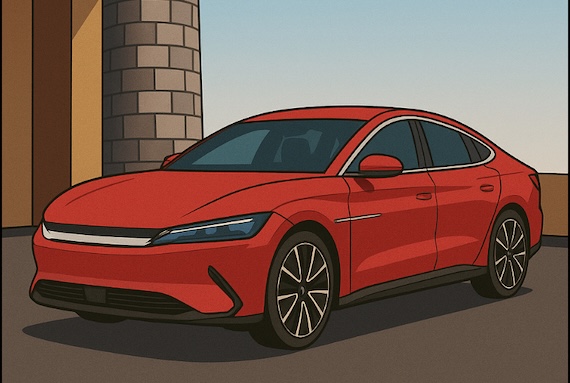Ann Arbor (Informed Comment) – Electric vehicles are expected to make up some 25% of cars sold globally in 2025, according to the International Energy Agency. Given where we were only a decade ago, this is a world-historical statistic. In 2016, EVs made up a little less than one percent of light vehicle sales.
The IEA writes, “For the full year 2025, electric car sales are expected to increase by 25% globally, which is similar to the growth rate from the 2024. As a result, electric car sales top 20 million worldwide.” Something on the order of 77 million to 86 million cars are sold in the world annually. The IEA seems to be expecting total car sales to reach around 80 million in 2025, despite admitted economic uncertainties (i.e. Trump’s tariffs and other countries’ counter-tariffs). And EVs will comprise a quarter of that total.
Last year, in 2024, some 17 million EVs were sold, which they estimate to have made up a fifth of car sales that year. But the increase from last year to this of an expected extra 3 million EV purchases nearly equals all the EVs sold in 2020, just five years ago.
Although a fourth of all cars bought this year worldwide will be electric, their production and purchase are very unevenly distributed around the world. In China, a solid majority — 60% — of new car sales will be electric.
The world produced nearly 104 million barrels of petroleum per day last year. The IEA expects electric vehicles to displace 5 million barrels a day worldwide by 2030. China may have already started down the path of decreasing oil imports every year, which is bad news for Iran and Saudi Arabia, which make gobs of money selling petroleum to China.
In the European Union, EV sales have been pumped up by EU carbon reduction targets and by government subsidies, which are coming to an end in many countries. Still, the IEA sees some signs that EVs are so attractive to consumers that they are buying them even without subsidies. It writes,
“At the end of 2024, the electric car purchase subsidy in the Netherlands came to an end, but electric car sales in the country in the first quarter of 2025 were about 10% higher than during the same period of 2024. In Italy, direct purchase subsidies for electric cars are no longer being renewed after 2024, though the government does aim to support the domestic production of EVs. In the first three months of 2025, electric car sales in Italy were up almost 50%.”
So that’s good news if it continues.
One caution here is that the market share of EVs in Italy, at 10% of new car sales, is still very low compared to some other European countries.
Autovista24 gives the following percentage of the auto market share captured by EVs in major Western European countries year to date:
UK: 30.2%
Germany: 27.2%
France 23.6%
Spain: 14.7%
Europe is expected to match the global average for percentage of new cars that are EVs, at about 25%, this year.
The US is like Italy — about 10% of new car sales in Q1 of 2025 were plug-in vehicles, whether battery-electric or plug-in hybrids. What will happen the rest of the year is anyone’s guess, since autos are very tariff-sensitive, and the Republicans want to kill EV tax subsidies. But, see above — in Europe consumers seem to be electrifying even without the subsidies. There is a lot of American interest in Chevy’s Equinox, in Audi EVs, and other brands even as Elon Musk has made his Tesla brand toxic, such that Tesla sales have plummeted. But other models, which are multiplying are taking up the slack.
The US is anyway increasingly irrelevant, under GOP/ MAGA rule, to vehicle electrification, since Republican politicians have been bought and paid for by Big Oil.
Moreover, China’s dominance in this industry is likely to continue and even be accelerated by Trump’s policies in the United States. The IEA estimates that by 2030, some 80% of new vehicle sales in China will be electric.
Such IEA projections, however, cannot account for likely technological and cost breakthroughs, so China may do even better than 80% — and remember, this is only in five years.

“BYD,” Digital, ChatGPT, 2025
China’s BYD has brought out the Seagull EV, with a sticker price of $16,000, and is selling it to Europe. Unlike with internal combustion engine cars, electric vehicles can get substantially cheaper over time. The major cost is the battery, and constant breakthroughs are being made, in China at least, in battery cost and efficiency. EV costs over the next 10 to 15 years could fall to $10,000 and even lower if the right scientific advances are made.
The problem is that these breakthroughs are now likely to be made in China, Germany, Korea and Japan, and by the time the US comes out of its MAGA drunken stupor, our dirty, world-wrecking old gasoline cars will be worthless and we won’t be the innovators that provide the inexpensive EVs to the world. We will de-industrialize ourselves because people adore Donald Trump, who does not understand basic economics, technology, or science.


 © 2025 All Rights Reserved
© 2025 All Rights Reserved